wisconsin
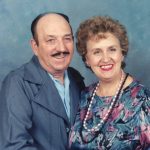
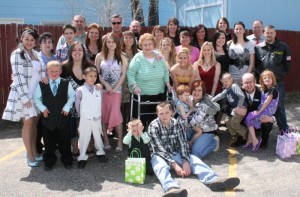 Five years is such a long time, and yet such a short time. I simply can’t believe that my mom has been in Heaven that long. The day she left us is still vivid in my memory files. It is a picture I will never get out of my head. There are a few scenes in my head that are that way. I try not to focus on them. They don’t need to be re-run to keep their memory alive. I try to focus on the happier past…the memories of the good times with my mom.
Five years is such a long time, and yet such a short time. I simply can’t believe that my mom has been in Heaven that long. The day she left us is still vivid in my memory files. It is a picture I will never get out of my head. There are a few scenes in my head that are that way. I try not to focus on them. They don’t need to be re-run to keep their memory alive. I try to focus on the happier past…the memories of the good times with my mom.
Collene Spencer was a bit of a shy girl, but she knew a good looking man when she saw one. For her, falling in love with my dad was like breathing…and she never looked back. Mom didn’t really like school, so that was not something that had any hold on her. She wanted to be married and have a family. I don’t really know if that had been her dream, before she met my dad, but it certainly was after that meeting. Their honeymoon was a move East to Superior, Wisconsin where Dad’s family was from and still lived. Mom’s family liked the idea too, because it gave them someplace to go visit. It was a beautiful place to visit too, so that was a plus. While mom eventually wanted to and did move back, her family wished she had stayed, so they could justify more visits.
After having their first two daughters, Cheryl Masterson, and me in Superior, Mom and Dad had the rest, Caryl Reed, Alena Stevens, and Allyn Hadlock here in Casper, Wyoming, where Mom’s family mostly lives. I have always thought we were very blessed to have so much family around us. That has never really been made so clear as when we became orphans. That’s when family really means a lot. My sisters, and our families first and foremost, of course, but aunts, uncles, and especially cousins have stepped in too…making us feel loved and comforted. I will always miss my parents…until the day I join them in Heaven. They taught us so many things, 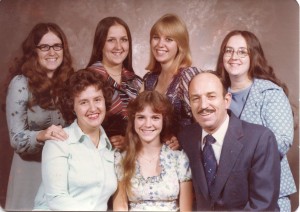
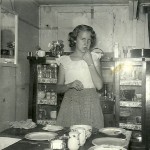 and it is because of their upbringing that we are the women we are today. The best we can do is make them proud of the people their children have become. I can’t believe that my mom has been in Heaven for five long years now. It seems an impossible number of years. While it seems just seconds ago to those who are there, mostly because that’s how eternity works, for the rest of us, the days feel much longer. We love and miss you Mom, and we can’t wait to see you again.
and it is because of their upbringing that we are the women we are today. The best we can do is make them proud of the people their children have become. I can’t believe that my mom has been in Heaven for five long years now. It seems an impossible number of years. While it seems just seconds ago to those who are there, mostly because that’s how eternity works, for the rest of us, the days feel much longer. We love and miss you Mom, and we can’t wait to see you again.
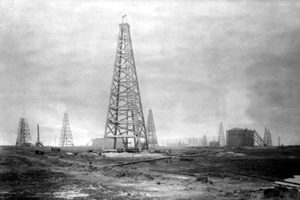 While most of the economy in Southeast Texas depended on agriculture, cattle ranching, and the lumber business in the 19th century, things were about to change. The presence of oil was known, but untapped until 1901 when the oil industry would change the landscape of the region. Uses for oil date back many years. In the 1500s, the Spanish used oil from seeps near Sabine Pass for caulking their ships, and to the north, settlers near Nacogdoches used seeping oil for lubricants before 1800. There were numerous discoveries in east and central Texas in the later 1800s, especially at Corsicana in 1896. Attempts were made to drill wells at Spindletop 1893 and 1896 and at Sour Lake in 1896, but they had no successful oil production along the Gulf Coast until the Lucas Gusher came in on Spindletop Hill on January 10, 1901.
While most of the economy in Southeast Texas depended on agriculture, cattle ranching, and the lumber business in the 19th century, things were about to change. The presence of oil was known, but untapped until 1901 when the oil industry would change the landscape of the region. Uses for oil date back many years. In the 1500s, the Spanish used oil from seeps near Sabine Pass for caulking their ships, and to the north, settlers near Nacogdoches used seeping oil for lubricants before 1800. There were numerous discoveries in east and central Texas in the later 1800s, especially at Corsicana in 1896. Attempts were made to drill wells at Spindletop 1893 and 1896 and at Sour Lake in 1896, but they had no successful oil production along the Gulf Coast until the Lucas Gusher came in on Spindletop Hill on January 10, 1901.
Spindletop Hill was a salt dome oil field, that was located in the southern portion of Beaumont, Texas. People had long suspected that oil might be under the hill as the area had been known for its sulfur springs and  bubbling gas seepages that would ignite if lit. Then in August, 1892, several men including George W. O’Brien, George W. Carroll, and Pattillo Higgins formed the Gladys City Oil, Gas, and Manufacturing Company to do exploratory drilling on Spindletop Hill.
bubbling gas seepages that would ignite if lit. Then in August, 1892, several men including George W. O’Brien, George W. Carroll, and Pattillo Higgins formed the Gladys City Oil, Gas, and Manufacturing Company to do exploratory drilling on Spindletop Hill.
By September 1901, there were at least six successful wells on Gladys City Company lands. Wild speculation drove land prices around Spindletop to incredible heights. One man who had been trying to sell his tract there for $150 for three years sold his land for $20,000; the buyer promptly sold to another investor within fifteen minutes for $50,000. One well, representing an initial investment of under $10,000, was sold for $1,250,000. Legal entanglements and multimillion-dollar deals became almost commonplace. An estimated $235 million had been invested in oil that year in Texas; while some had made fortunes, others lost everything.
Following the success of the oil industry at Spindletop Hill, many people, including my grandparents, Allen and 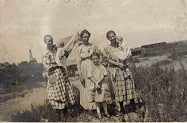 Anna Spencer would make their way to Texas in search of a better life. They would settle on the oilfields near Ranger, Texas. They didn’t find any oil fields, so their income came from his work for other people in the oilfields. These days people working in the oilfield business make good money, but as near as I can tell oilfield workers averaged about 90 cents an hour in 1919, which would be about $11.74 an hour today. That’s pretty poor wages, especially for the oilfield, but I suppose people didn’t realize how valuable they really were. Needless to say, the oilfield was not the place my grandfather would choose to make his living, and eventually they returned to Wisconsin where he went to work for the railroad.
Anna Spencer would make their way to Texas in search of a better life. They would settle on the oilfields near Ranger, Texas. They didn’t find any oil fields, so their income came from his work for other people in the oilfields. These days people working in the oilfield business make good money, but as near as I can tell oilfield workers averaged about 90 cents an hour in 1919, which would be about $11.74 an hour today. That’s pretty poor wages, especially for the oilfield, but I suppose people didn’t realize how valuable they really were. Needless to say, the oilfield was not the place my grandfather would choose to make his living, and eventually they returned to Wisconsin where he went to work for the railroad.
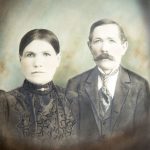 As American became populated, the immigrants brought with them, so much more than their belongings. I recently received my copy of the “Wisconsin Magazine of History” from the Wisconsin Historical Society, of which I am a member, and one of the cover stories was entitled, “German Brewing in Early Wisconsin.” Because I come from a strong German background, and was born in Wisconsin, this story was of particular interest to me. It seems that, while beer brewing in the United States began with the English, in the mid-1800s, but beer drinking was common in much of Europe, and in all levels of society, which surprised me some. We tend to expect that, higher society people would never drink beer, but the reality is that that is only in more recent years. The reality is that because on the lack of knowledge of sanitation and disease causing pathogens, many of the drinks people could make out of ordinary water really weren’t very safe to drink. Beer, on the other hand because it had to be boiled and fermented, did away with all those organisms, making it safe to drink. That made beer a very common drink by the Middle Ages. It was even given to the children.
As American became populated, the immigrants brought with them, so much more than their belongings. I recently received my copy of the “Wisconsin Magazine of History” from the Wisconsin Historical Society, of which I am a member, and one of the cover stories was entitled, “German Brewing in Early Wisconsin.” Because I come from a strong German background, and was born in Wisconsin, this story was of particular interest to me. It seems that, while beer brewing in the United States began with the English, in the mid-1800s, but beer drinking was common in much of Europe, and in all levels of society, which surprised me some. We tend to expect that, higher society people would never drink beer, but the reality is that that is only in more recent years. The reality is that because on the lack of knowledge of sanitation and disease causing pathogens, many of the drinks people could make out of ordinary water really weren’t very safe to drink. Beer, on the other hand because it had to be boiled and fermented, did away with all those organisms, making it safe to drink. That made beer a very common drink by the Middle Ages. It was even given to the children.
Upon reading this, I wondered if my German great grandparents made beer in their home. I thought about the 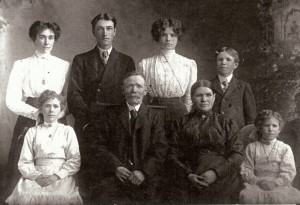 journal my Aunt Bertha Schumacher had written, but she never mentioned beer. I suppose it could have been because it was so common in the home, that it never occurred to her. Or could it have been because they were the exception to the rule, and didn’t really drink beer in their household. It’s hard to say, but when something is as much a cultural and traditional practice, it seems to me unlikely that they would not have done thing in the same way their families did at home. After studying German in high school, I knew that beer was talked about in many of the dialogues we learned. It just seemed to me, like it was a way to learn the words, and now a way of life, but perhaps I had been wrong on that. I suppose it could have been that because family meals in the United States, these days anyway, did not include beer, wine, or any other alcoholic drink of any kind, on a regular basis, was pretty much unheard of. It just didn’t seem like an normal activity, but in the time that my German great grandparents immigrated to the United States, drinking beer was very
journal my Aunt Bertha Schumacher had written, but she never mentioned beer. I suppose it could have been because it was so common in the home, that it never occurred to her. Or could it have been because they were the exception to the rule, and didn’t really drink beer in their household. It’s hard to say, but when something is as much a cultural and traditional practice, it seems to me unlikely that they would not have done thing in the same way their families did at home. After studying German in high school, I knew that beer was talked about in many of the dialogues we learned. It just seemed to me, like it was a way to learn the words, and now a way of life, but perhaps I had been wrong on that. I suppose it could have been that because family meals in the United States, these days anyway, did not include beer, wine, or any other alcoholic drink of any kind, on a regular basis, was pretty much unheard of. It just didn’t seem like an normal activity, but in the time that my German great grandparents immigrated to the United States, drinking beer was very 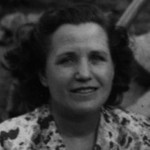 normal, so I have no reason to believe that they didn’t drink it, just like everyone else.
normal, so I have no reason to believe that they didn’t drink it, just like everyone else.
When the German immigrants arrived in America, they were required to brew their own beer. Since wheat was abundant, barley and hops easy to grow, they had no problem making their beer. I must wonder if they used whet at that time, though, because the German recipe did not include wheat, because it was needed for bread in Germany, and it wasn’t as abundant as it was in the United States. The east coast with its heat and long growing season, didn’t make a good brewing climate. When the people moved to Wisconsin, they found the climate, especially in the Milwaukee area was perfect, and I suppose the rest is history, for German beer and for Milwaukee.
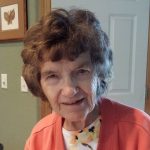
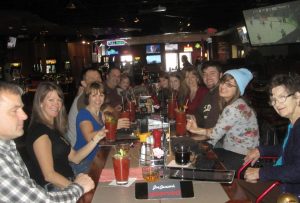 Four years ago, my mom, Collene Spencer; my sister, Cheryl Masterson; and I took a trip back to Superior, Wisconsin, which is where Cheryl and I were born. While we were there, we were invited to Julie Carlson Soukup’s home for dinner. My mom knew the parents of these cousins who had welcomed us into their home. Cheryl and I did too, but it had been a number of years since we had seen them, and certainly, most of the cousins themselves were totally new to us. We watched as the Carlson kids brought their mother, Carol Carlson to the dinner. She had been dealing with Lewy Body Dementia, which is much like Alzheimer’s disease, but with the added issue of motor problems. These kids were so careful with her, and so determined that she be able to come for this visit. It brought tears to my eyes to see such love. Having been a caregiver for a long time, I knew how much work caregiving is, but they didn’t care what it took. She was their mom.
Four years ago, my mom, Collene Spencer; my sister, Cheryl Masterson; and I took a trip back to Superior, Wisconsin, which is where Cheryl and I were born. While we were there, we were invited to Julie Carlson Soukup’s home for dinner. My mom knew the parents of these cousins who had welcomed us into their home. Cheryl and I did too, but it had been a number of years since we had seen them, and certainly, most of the cousins themselves were totally new to us. We watched as the Carlson kids brought their mother, Carol Carlson to the dinner. She had been dealing with Lewy Body Dementia, which is much like Alzheimer’s disease, but with the added issue of motor problems. These kids were so careful with her, and so determined that she be able to come for this visit. It brought tears to my eyes to see such love. Having been a caregiver for a long time, I knew how much work caregiving is, but they didn’t care what it took. She was their mom.
I didn’t know Carol well, but over the years, I watched as the Carlson family centered life around her. They took her so many places, and everywhere they went was an event, documented with lots of pictures. They were, of course, building their memories, knowing that the future was uncertain. They didn’t want to think about the day when Carol would no longer be with them. Right before we came for that visit, they had just had to move Carol into an nursing home, because she could no longer live on her own. Once again they showed her the greatest love they could have for her. They told her about her life, the life that had begun to slip away from her memory files. They needed to preserve it for her somehow.
When Carol passed away, on August 2nd, 2018, I began to recall the many beautiful things the Carlson family had done for her, but I realized that I didn’t really know much about her life. I wanted her children to share some of their favorite memories with me, because I knew that I wanted to write a tribute to their beautiful mother. They decided that they would send me a copy of the letter written by her oldest daughter, Laurie Carlson Stepp at the time they moved Carol into the nursing home. The children put together a scrap book filled with letters from her children and grandchildren, poems she had written, stories about her, such as her sayings…things they had heard her say all their lives, and pictures for her to see. It was their gift to their mother…her memories. They were giving them back to her.
I could never begin to write her memories with the beauty that her children and grandchildren did. Their 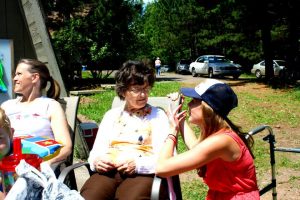
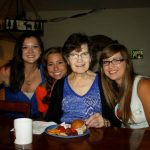 memories of her were their gift of love to her, and that is beyond special. Nevertheless, I want to try to highlight some of the wonderful things Carol Schumacher Carlson did in her lifetime. The reality is that Carol almost didn’t exist. Laurie tells that story in her letter to her mom, “Your parents, Fred and Anna Schumacher already had one lovely daughter, Beatrice. When she was born, there were serious difficulties and the doctor told Fred that he would have to choose between his wife and the baby. He chose his wife……she chose the baby! They were both saved, but the doctor cautioned against having any more children. So that is why you Carol were a miracle baby.” The faith of her parents brought about Carol’s life, as well as nine siblings after her. The letter told of the help Carol gave her mom with her younger siblings, Leslie, Carl, Margaret, Gilbert, Delwin, Noreen, Bernice, Bob, and Dale.
memories of her were their gift of love to her, and that is beyond special. Nevertheless, I want to try to highlight some of the wonderful things Carol Schumacher Carlson did in her lifetime. The reality is that Carol almost didn’t exist. Laurie tells that story in her letter to her mom, “Your parents, Fred and Anna Schumacher already had one lovely daughter, Beatrice. When she was born, there were serious difficulties and the doctor told Fred that he would have to choose between his wife and the baby. He chose his wife……she chose the baby! They were both saved, but the doctor cautioned against having any more children. So that is why you Carol were a miracle baby.” The faith of her parents brought about Carol’s life, as well as nine siblings after her. The letter told of the help Carol gave her mom with her younger siblings, Leslie, Carl, Margaret, Gilbert, Delwin, Noreen, Bernice, Bob, and Dale.
Carol was a hard worker all her life. She worked at Hills Brothers Dairy, then for a lawyer in Billings Park babysitting their children, as a waitress at the Princess Sweet Shop, at Phoenix Hosiery, at Twin Ports Dairy…where she did office work, and at Kempenski Glass Company. All these were jobs, but her real life’s work was to be the mother of her children. Carol married Donald John Carlson on August 21, 1954, and they would be blessed with Donny, Laurie, Steve, Dave, Jim and twins – Julie and Jeanne. Carol also had bonus children, Bonnie and Randy, from Don’s first marriage. Carol was a housewife, and very good at her job. They grew a big garden, canned and froze enough food to keep the family in vegetables most of the year. Their dad would come home and there was always a flurry of activity and fun. Carol cooked, cleaned, sewed, and took care of her family, and still had time to help out others too. The children always came home from school to some kind of homemade snack, but more importantly…they came home to their mom, Carol, who welcomed them with open arms. Carol baked 5 loaves of bread every day and packed countless lunches. She sewed clothes for her family and often surprised them with something new that they needed after staying up all night working with her sewing machine until it was finished. She made clothes, quilts, tents, and just about anything that could be made with cloth for her family and for her grandchildren too. She made Indian costumes with real tepees, which have been used by most of her grandsons. She made a pair of sandals for Jon and Josh when they were starting to walk, Prom dresses, bridesmaid dresses, suits, pants, skirts, shirts, blouses…the family was always wearing something Carol had made. They have always felt so blessed to have Carol in their lives.
When I set out to write this tribute to Carol Schumacher Carlson, I wanted it to be about the amazing things 
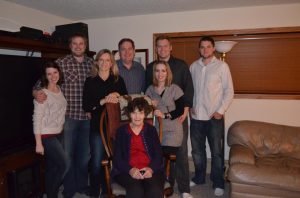 she did for those she loved. Little did I know that it would be about the amazing children she raised, but in reality, it had to be about her amazing children, because that was what Carol was all about. Her whole life was spent giving of herself to those she loved and cared about. It was Carol, who along with her husband, Don raised these kids to be the loving, responsible adults that they have become. That, in itself, is a tribute to Carol. Her hard work for her family, was her gift to them, and they were her reward…her legacy.
she did for those she loved. Little did I know that it would be about the amazing children she raised, but in reality, it had to be about her amazing children, because that was what Carol was all about. Her whole life was spent giving of herself to those she loved and cared about. It was Carol, who along with her husband, Don raised these kids to be the loving, responsible adults that they have become. That, in itself, is a tribute to Carol. Her hard work for her family, was her gift to them, and they were her reward…her legacy.
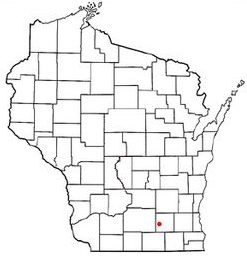 When we think of rain showers, most of us think of a pleasant spring or summer afternoon when the day is hot, and the rain cools things down, and everything smells so good, but on a beautiful April day in 1897 in Jefferson County, Wisconsin, and particularly in the town of Palmyra, the shower they received was not so pleasant. That morning, after a shower overnight, residents woke up expecting to see puddles of rainwater here and there, but instead the sight they saw was appalling. It was like nothing they had ever seen before.
When we think of rain showers, most of us think of a pleasant spring or summer afternoon when the day is hot, and the rain cools things down, and everything smells so good, but on a beautiful April day in 1897 in Jefferson County, Wisconsin, and particularly in the town of Palmyra, the shower they received was not so pleasant. That morning, after a shower overnight, residents woke up expecting to see puddles of rainwater here and there, but instead the sight they saw was appalling. It was like nothing they had ever seen before.
On the ground, the cars, and every other surface in the area were thousands of worms…and they weren’t worms anyone knew about. They were a strange species that was unknown to the area. There was no place that the people could walk without stepping on the disgusting worms. People even had them in barrels that were designed to catch rainwater for drinking, so the drinking water was compromised too. Finally an expert fisherman and gardener, named Captain McDonald, told the people that they were Gilt-Edge Worms. He said that he could tell by their yellow and gold spots and rings. He said that he had used these particular worms for bait while fishing in Ireland.
Well, that was one thing, but Wisconsin is nowhere near Ireland, so how did they get there? Well, the people started to speculate that somehow the worms must have drifted across the ocean in a cloud, but when you think about it, that is an odd thought. Nevertheless, after having watched a story on The Weather Channel about a town that had fish fall out of the sky one time, and that they thought it might have been from a water spout that had scooped them up from a nearby water source, I suspect that something similar might have happened, although I don’t know if the same thing could have happened with a tornado over land, because I doubt if the Gilt-Edge Worm is a water dwelling creature. I don’t suppose they will ever know exactly how the incredible worm shower happened for sure, but while it was a disgusting situation at the time, the townspeople soon decided 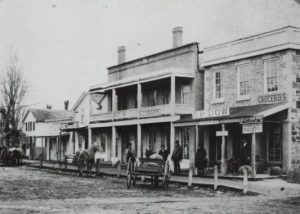 that they might as well make the best of it, and go fishing!!
that they might as well make the best of it, and go fishing!!
The captain told them that Trout found the worms particularly tasty, and hard to resist, especially in the muddy waters after a rainfall, so in very short order, the townspeople decided that it must have been Providence (another word for a gift from God) that brought the worms to their area so miraculously overnight, when trout fishing in the nearby lakes and streams was a universal pastime. So, after finding out about the worms value, I’m sure the people were a little more careful about where they were stepping, so they didn’t kill the worms that might help them catch more trout.
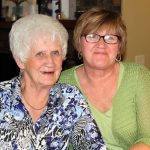 When I was a little girl, my family lived in Superior, Wisconsin. Those were wonderful years, but in more recent years we had not been back to Superior for a number of years. When my mom, Collene Spencer wanted to go back to Superior, my sister, Cheryl Masterson and I took her, since our dad had passed away by then. That, Ancestry, and Facebook opened up a whole new world for Cheryl and me. We got to know our cousins, and the list of cousins we know grows every day…or at least every year. This year, with the Schumacher Family Reunion, we knew we had to go, even though it would be without Mom this time. This trip was bittersweet, because of course, Mom was missing.
When I was a little girl, my family lived in Superior, Wisconsin. Those were wonderful years, but in more recent years we had not been back to Superior for a number of years. When my mom, Collene Spencer wanted to go back to Superior, my sister, Cheryl Masterson and I took her, since our dad had passed away by then. That, Ancestry, and Facebook opened up a whole new world for Cheryl and me. We got to know our cousins, and the list of cousins we know grows every day…or at least every year. This year, with the Schumacher Family Reunion, we knew we had to go, even though it would be without Mom this time. This trip was bittersweet, because of course, Mom was missing.
Nevertheless, we have had a wonderful time. When we were here the last time, our first cousins once removed, Les and Bev Schumacher had wanted us to come to their house, but our time was do limited, that we didn’t have time to. This time, their daughter, Cathy La Porte graciously invited us for dinner this evening. We got to meet her husband, Gary, as well as to see her brother, Brian Schumacher and his wife, Lisa again. It was simply a wonderful evening. Cathy is an excellent cook and we were treated to Walleye Pike and Northern Pike that Cathy’s husband, Gary caught in North Dakota with his brother this past  week. Wow!!! Was it good. Dessert was a Cherry Crumble that Lisa’s friend had given her, and everyone loved it.
week. Wow!!! Was it good. Dessert was a Cherry Crumble that Lisa’s friend had given her, and everyone loved it.
The evening was very enjoyable and will always be a sweet memory from our trip. The trip has gone by so fast, and what we thought was enough time, really wasn’t…it never is, is it? Nevertheless, the friendships (cousinships) formed will last for the rest of our lives, and while our parents weren’t there this time, we know they would be smiling…happy to see their daughters and granddaughter continue to reach out to the family as if they were with us. I guess we are carrying on the connections, and that would make them happy, and it makes me happy.
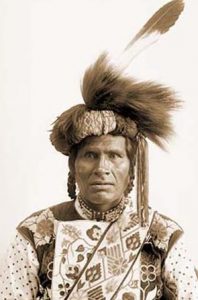 Many people think of the Indians as, well…simply the Indians, whether we intend to or not. I suppose that if we studied the different tribes, their noticeable differences would become very apparent, but if we don’t it’s not so easy to tell them apart. One of the lesser known tribes, at least early on in American history, was the Chippewa tribe. Speculation is that they were already settled in a large village at La Pointe, Wisconsin at about the time that America was discovered. Then, in the early 17th century, they abandoned this area. Many of them returning to their homeland in Sault Sainte Marie, Michigan, while others settled at the west end of Lake Superior, where they were found by Father Claude Jean Allouez, a Jesuit missionary and French explorer, in 1865.
Many people think of the Indians as, well…simply the Indians, whether we intend to or not. I suppose that if we studied the different tribes, their noticeable differences would become very apparent, but if we don’t it’s not so easy to tell them apart. One of the lesser known tribes, at least early on in American history, was the Chippewa tribe. Speculation is that they were already settled in a large village at La Pointe, Wisconsin at about the time that America was discovered. Then, in the early 17th century, they abandoned this area. Many of them returning to their homeland in Sault Sainte Marie, Michigan, while others settled at the west end of Lake Superior, where they were found by Father Claude Jean Allouez, a Jesuit missionary and French explorer, in 1865.
The Chippewa, also known as the Ojibway, Ojibwe, and Anishinaabe, are one of the largest and most powerful nations, having nearly 150 different bands located primarily in Minnesota, Wisconsin, Michigan, and southern Canada…especially Ontario, Manitoba and Saskatchewan. Ojibway means “to roast till puckered up.” It’s an odd name that referred to the puckered seam on their moccasins. Formerly, the tribe lived along both shores of Lakes Huron and Superior, extending across the Minnesota Turtle Mountains and North Dakota. They were strong in numbers and occupied an large territory, but the Chippewa were never prominent in history, mainly because of their remoteness from the frontier during the period of the colonial wars. They were part of an Algonquian group, including the Ottawa and Potawatomi, which divided when it reached Mackinaw in its westward movement.
Sault Saint Marie was their main headquarters about 1640, as mentioned by Jean Nicolet de Belleborne, a French-Canadian woodsman, who called them Baouichtigouin, meaning “people of the Sault”. In 1642, they 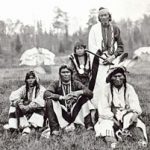 were visited by missionaries Charles Raymbaut and Isaac Jogues, who found them at the Sault and at war with a people to the west, who were probably the Sioux. Because they kept to themselves, away from the frontier, the Chippewa took a very small part in the early colonial wars, but the southern division of the tribe was known to be of warlike disposition. Those to the north of Lake Superior were considered to be peaceful. They were termed by their southern brothers as “the rabbits.” In the north, the members of the tribe were described as the “men of the thick woods” and the “swamp people,” terms used to designate the nature of the country they lived in.
were visited by missionaries Charles Raymbaut and Isaac Jogues, who found them at the Sault and at war with a people to the west, who were probably the Sioux. Because they kept to themselves, away from the frontier, the Chippewa took a very small part in the early colonial wars, but the southern division of the tribe was known to be of warlike disposition. Those to the north of Lake Superior were considered to be peaceful. They were termed by their southern brothers as “the rabbits.” In the north, the members of the tribe were described as the “men of the thick woods” and the “swamp people,” terms used to designate the nature of the country they lived in.
The Chippewa people living south of Lake Superior in the late 1600s were fishermen and hunters. They also grew corn and wild rice. Their possession of wild-rice fields was one of the chief causes of their wars with the Dakota, Fox, and other nations. At about this time, they came into possession of firearms, and began pushing their way westward, in a mixture at peace and war with the Sioux but in almost constant conflict with the Fox tribe. The French, in 1692, reestablished a trading post at Shaugawaumikong, now La Pointe Island, Wisconsin, which became an important Chippewa settlement. In the beginning of the 18th century the Chippewa succeeded in driving the Fox, already reduced by war with the French, from north Wisconsin, compelling them to take refuge with the Sac.
The Chippewa took part with the other tribes of the northwest in all the wars against the frontier settlements to 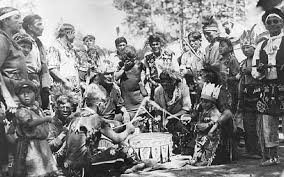 the close of the war of 1812. Those living within the United States made a treaty with the Government in 1815, and afterwards remained peaceful, residing on reservations or allotted lands within their original territory in Michigan, Wisconsin, Minnesota, and North Dakota. By 1900, the Chippewa were estimated to number about 30,000. Today, the collective bands of Chippewa or Ojibwe, are one of the largest groups of Native American People on the North American continent. There are communities in both Canada and the United States. In Canada, they are the second largest population among First Nations, surpassed only by the Cree. In the United States, they have the fourth largest population among Native American tribes, surpassed only by the Navajo, Cherokee and Lakota Sioux.
the close of the war of 1812. Those living within the United States made a treaty with the Government in 1815, and afterwards remained peaceful, residing on reservations or allotted lands within their original territory in Michigan, Wisconsin, Minnesota, and North Dakota. By 1900, the Chippewa were estimated to number about 30,000. Today, the collective bands of Chippewa or Ojibwe, are one of the largest groups of Native American People on the North American continent. There are communities in both Canada and the United States. In Canada, they are the second largest population among First Nations, surpassed only by the Cree. In the United States, they have the fourth largest population among Native American tribes, surpassed only by the Navajo, Cherokee and Lakota Sioux.
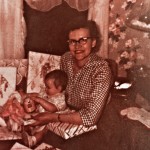 When my parents moved to Superior, Wisconsin, which is where my older sister, Cheryl Masterson and I were born, my mom was a young bride, who was experiencing the first days of marriage and the first time away from her family. I’m sure that was not really an easy time for her, but when she arrived in Superior, she was greeted by my dad’s family, who were the only people she knew there. If you have to move to a new city and state, it is nice to at least have someone that you know and can call family, as well as friend. My dad had a large family in the area with whom my mother became quite close, one of whom was my Aunt Doris Spencer, her sister-in-law, and my Uncle Bill’s wife. They spent a lot of time together, and really, had a number of “adventures” together.
When my parents moved to Superior, Wisconsin, which is where my older sister, Cheryl Masterson and I were born, my mom was a young bride, who was experiencing the first days of marriage and the first time away from her family. I’m sure that was not really an easy time for her, but when she arrived in Superior, she was greeted by my dad’s family, who were the only people she knew there. If you have to move to a new city and state, it is nice to at least have someone that you know and can call family, as well as friend. My dad had a large family in the area with whom my mother became quite close, one of whom was my Aunt Doris Spencer, her sister-in-law, and my Uncle Bill’s wife. They spent a lot of time together, and really, had a number of “adventures” together.
As young women, they were always weight conscious, and always on the latest diet. I’m sure that they thought it would be easier to diet with a buddy, and many of us have thought the same thing, but as we all know, dieting is never ease, and inevitably, they found themselves starving!! So, as a way of easing the cravings until they could eat something again, my Aunt Doris handed gave each of them one kernel of puffed wheat and said, “Here, this will tide us over until dinnertime!” Now, as we all know that would be like literally eating air, and it would not ease hunger pains in any way, but as every dieter knows, it was worth a try, because they didn’t want to mess up their diet.
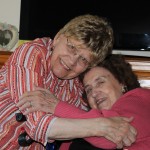 When we moved to Wyoming when I was a little over two years old, it was hard on a lot of people, but I think it was especially hard for my mom and Aunt Doris. While their “adventures” were sometimes silly and sometimes almost crazy, they always had a great time together, and they had become almost like sisters, not sisters-in-law. Aunt Doris and Uncle Bill visited us in Wyoming and we visited them in Wisconsin, but it was never quite the same. Then a few years ago, my sister, Cheryl and I took Mom to Wisconsin for a visit. it was so amazing to see the two sisters-in-law/friends together again, and I know they felt like it was an amazing reunion too. It was the last trip my Mom would make, but my Aunt Doris is still alive and going strong. Today is Aunt Doris’ 94th birthday. Happy birthday Aunt Doris!! Have a great day!! We love you!!
When we moved to Wyoming when I was a little over two years old, it was hard on a lot of people, but I think it was especially hard for my mom and Aunt Doris. While their “adventures” were sometimes silly and sometimes almost crazy, they always had a great time together, and they had become almost like sisters, not sisters-in-law. Aunt Doris and Uncle Bill visited us in Wyoming and we visited them in Wisconsin, but it was never quite the same. Then a few years ago, my sister, Cheryl and I took Mom to Wisconsin for a visit. it was so amazing to see the two sisters-in-law/friends together again, and I know they felt like it was an amazing reunion too. It was the last trip my Mom would make, but my Aunt Doris is still alive and going strong. Today is Aunt Doris’ 94th birthday. Happy birthday Aunt Doris!! Have a great day!! We love you!!
 Yesterday, my family lost another of my uncles, when my Uncle Bill Beadle went home to heaven. He has been ill for some time, but that just doesn’t help you to be ready for his home going. Nothing really prepares you for that. He went peacefully in his chair, having slept through the night and awakened in his sleep, got up to watch television. It was there that Aunt Virginia found him when she got up in the morning. Knowing that Uncle Bill went home peacefully, eases my mind a little, but when I think of the many years they have been married, and how sad she is, I am very sad indeed.
Yesterday, my family lost another of my uncles, when my Uncle Bill Beadle went home to heaven. He has been ill for some time, but that just doesn’t help you to be ready for his home going. Nothing really prepares you for that. He went peacefully in his chair, having slept through the night and awakened in his sleep, got up to watch television. It was there that Aunt Virginia found him when she got up in the morning. Knowing that Uncle Bill went home peacefully, eases my mind a little, but when I think of the many years they have been married, and how sad she is, I am very sad indeed.
My cousin, Elmer Johnson, recalled that Uncle Bill was born up around Worland, Wyoming. He worked in the pipe yards, owned his own rathole drilling business with both sons, Forrest and Steve by his side. Uncle Bill was a great machinist and general all around mechanic. He loved spending time with Steve fishing and he loved to go bird hunting up around Worland. Pheasant and Chukars were his favorites, He liked hunting them, because it was much more exciting, walking the fields with that unexpected bird flying up out of nowhere giving only seconds to make the shot. Uncle Bill always had that cantankerous spirit…in the best ways, and had a way of getting you turned around and talked into doing the right thing if you were headed off course. He enjoyed his pipe, for quite a few years, and his chew. Forrest and Elmer got into that big block of chew when they were kids, didn’t know not to swallow it… well, when they swallowed it, they turned about three shades of green. Elmer tells me that he still can’t deal with chewing tobacco!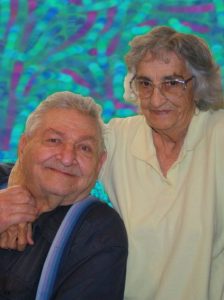
My sisters, Cheryl Masterson, Caryl Reed, Alena Stevens, Allyn Hadlock, and I were reminiscing last night about all the wonderful years since Uncle Bill joined our family. We all agreed that Uncle Bill had an incredible smile, complete with a mischievous twinkle in his eyes. He loved to tease the kids, and we all loved to be teased. Then he would laugh with his infectious laugh, and we all had a thoroughly great time. Uncle Bill was really not serious very much, at least not around us, or most of the kids. It just wasn’t a real part of his nature, unless you were heading for trouble…then he would get serious, but not in a mean way. Rather, as Elmer said, “He had a way of getting you turned around and talked into doing the right thing if you were headed off course.” And it happened before you even knew it was happening. That was Uncle Bill, and we will miss him very much. Rest in peace Uncle Bill. We love you.
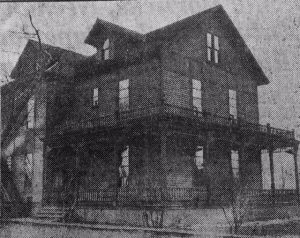 Many years ago, anyone suffering from a communicable disease in Superior, Wisconsin, who wanted to save other family members from becoming ill could be treated at the Isolation Hospital. Superior’s twenty six room Isolation Hospital was located at 2222 East 10th Street, in Superior, Wisconsin. The hospital treated such diseases as smallpox, scarlet fever, diphtheria, and meningitis. Each of the diseases were treated in separate wards of the building, in an effort to isolate on illness from another. The hospital was managed by Mr and Mrs Peter Roe. The hospital always had a registered nurse on duty and patients could hire a private nurse as well, if needed. Mrs Roe cooked all the meals for the patients under the direction of their attending physicians. To help the patients pass the time while they were confined, “The Evening Telegram” and Superior citizens raised money for a radio. The hospital was under the supervision of Dr George Conklin. Because it was harder to cure diseases in days gone by, people might find themselves confined for some time, even the rest of their lives.
Many years ago, anyone suffering from a communicable disease in Superior, Wisconsin, who wanted to save other family members from becoming ill could be treated at the Isolation Hospital. Superior’s twenty six room Isolation Hospital was located at 2222 East 10th Street, in Superior, Wisconsin. The hospital treated such diseases as smallpox, scarlet fever, diphtheria, and meningitis. Each of the diseases were treated in separate wards of the building, in an effort to isolate on illness from another. The hospital was managed by Mr and Mrs Peter Roe. The hospital always had a registered nurse on duty and patients could hire a private nurse as well, if needed. Mrs Roe cooked all the meals for the patients under the direction of their attending physicians. To help the patients pass the time while they were confined, “The Evening Telegram” and Superior citizens raised money for a radio. The hospital was under the supervision of Dr George Conklin. Because it was harder to cure diseases in days gone by, people might find themselves confined for some time, even the rest of their lives.
Smallpox was probably the most widespread medical terror in our past. Smallpox outbreaks occurred in 1894 and 1872, and the state was swept by cholera in 1849. The same disease had decimated the troops at Fort Crawford in August 1833, taking down 23 soldiers and killing six. But the most notorious epidemic in our history was surely the Lake Superior smallpox outbreak of 1770, when the British deliberately introduced the disease among the Ojibwa Indians in revenge for the death of a fur trader. At least 300 people around modern Duluth-Superior were killed in this early act of bioterrorism. In August of 1895, smallpox had swept through the south side of Milwaukee where the traditions of recent Polish immigrants clashed with modern public health practices. The first patients were segregated at the Isolation Hospital outside the neighborhood, even though the residents preferred caring for their own sick in their own homes, as they had in the old country. When hospital patients began dying, the residents came to see it as a slaughterhouse where they would never send their loved ones. This only increased the spread of disease, of course, and soon thousands were affected. But when city health officials or ambulances attempted to remove patients to protect the uninfected, they were met by barricaded doors and armed uprisings.
Eventually Saint Mary’s Hospital replaced the Isolation Hospital. The new hospital was finished in 1911, but it 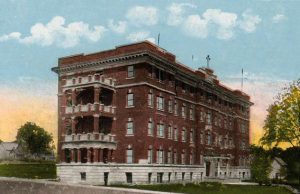 was the smallpox outbreak of May, 1915 that really put it to the test. The outbreak in Madison filled the hospitals and even took down the staff at Saint Mary’s, including the nurses and nuns. Smallpox was a terrible disease, for which there was no immunization in early years. Now with much hard work, and scientific research, it is considered a disease of the past. It also bears mentioning, that today, every time there is an outbreak of a contagious disease, doctors, nurses, staff, as well as friends and family wear protective gowns, gloves, and masks, in an effort to stop the spread of the disease. Medicine has come a long way since the days of the 1894 Smallpox epidemics. There are many ways to help people fight and win their battle against disease.
was the smallpox outbreak of May, 1915 that really put it to the test. The outbreak in Madison filled the hospitals and even took down the staff at Saint Mary’s, including the nurses and nuns. Smallpox was a terrible disease, for which there was no immunization in early years. Now with much hard work, and scientific research, it is considered a disease of the past. It also bears mentioning, that today, every time there is an outbreak of a contagious disease, doctors, nurses, staff, as well as friends and family wear protective gowns, gloves, and masks, in an effort to stop the spread of the disease. Medicine has come a long way since the days of the 1894 Smallpox epidemics. There are many ways to help people fight and win their battle against disease.

